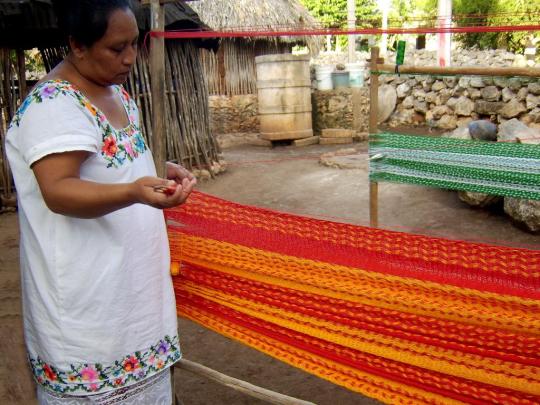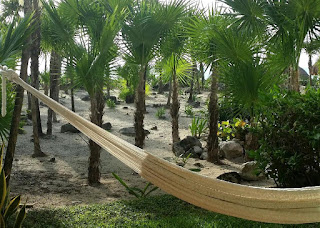Getting in of a hammock
Sit with your back to the hammock, as if about to sit in a chair. Grasp behind you and out the hammock before sitting. This ensures maximum use of space and the weight is distributed evenly. Now sit back and lean back NEVER climb in feet first.
Getting out of the hammock
Swing your legs over the side to sit. Then, hold firmly to the side of the hammock stand.
LOOKING getting settled
The easiest way is at an angle, this allows you to sleep with a better distribution of weight, lower stress, and back support for comfort. Some hammocks are best when it extends through the center in the double hammocks can sit two people in a variety of positions. You can experience and find your favorite.
HANG THE HAMMOCK
Home use
The home use vary from the porch, living between two columns in the room etc. Hang with hammocks or hammock supports. You can use a rope to compensate for the extra distance.
Outdoor use
Use the other side of the house or garage. Use a strong pole or plant your own post to hang. You can also use available or palm trees serve as columns. Two strings at the correct distance if there are trees or usable walls, place to hang your hammock between them. The approximate distance to hang your hamca is 3.6 meters.
Supplier of hammocks cotton and nylon, USA, Canada, Europe and rest of the world fast shipping, quality on our products hammocks are handmade by hammocks rada profesional artisans in remote villagues outside of capital yucatan
Mayan Hammocks
25 sept 2015
14 sept 2015
Mayan hammock weave
Mayan hammocks are hand-woven on a horizontal wooden frame. The frame is made of wood and consists of 2 vertical posts 2.20 meters apart the racks are handmade by the artisans themselves on occasion from trees nearby. They are lightweight, yet strong, and can be easily moved inside or outside your home. It is not uncommon to see women weaving hammocks outside or inside the house when hot.
The hammock is pure yarn interlaced with one another, the ability to unite Weaver infinite patterns can be created by changing colors and weaving them hammock it is a repetitive and sometimes long process with no particular pattern, resulting in multiple deck colors and designs.
Mayan hammock weave
During the weaving process it is very important to maintain a constant and even tension in the mesh. If the thread tension is too tight then a part of the hammock will have a lump or might be too soft.
Many people believe weave a hammock is easy to learn. The work involved in creating a multi-colored hammock is considerably more complex because the color changes when there is a break in the fabric to tie the knots together. The more nodes the longer the fabric to the Mayan hammock. That is why there is often a tendency for mass producers to create less complex designs.
Fortunately there are still some quality producers in Mexico, as crafters doing fine Yucatan Mayan hammocks in traditional designs and more laborious.
9 sept 2015
How to care a hammock easily?
FIG.1
To wash hammock: Hand wash in mild detergent (colors may bleed some) Always tie up arm strings to avoid tangles. Put inside a pillow case while washing.
To store hammock hang both ends from one hook on the wall, or fold it up and store it (fig.1) Do not leave it lying around unfalded.
Weather: hammocks last longer if not left out exposed to the elements. Cotton hammocks are more durable than synthetics wich break down under
the suns ultraviolet rays. Still, it is best to store your hammock indoors when not in use.
Do not hang hammock directly on hooks as friction wearing may occur. Instead loop a chain or rope from hook through the loop end of the hammock and back to hook (fig.2)
Always hold hammock by loop ends to avoid tang to repair: Should a string break on an open wave hammock, it will not run, however, you must tie the two broken ends together to avoid the
development of a hole.
8 sept 2015
History about hammocks
The hammock is a bundle of thread, string or fabric suspended in the air held only at its ends and is used mostly for sleep, relax or making rocking swing like a swing. Normally hammocks are panels of yarn or woven together to form a body big and strong to support the weight of at least one person, in different regions of the world also enough fabric is used to manufacture them ropes. Originally hammocks were used by the ancient Maya to rest and sleep, centuries later began to use to rest and sleep in places with smaller spaces in which it was not possible to have access to a bed or chair.

For thousands of years indigenous peoples have woven hammocks. Besides tomatoes, corn, potatoes and cocoa, Europeans have learned from the Mayas people and the utility that others can have a hammock. Hammocks RADA (c) has combined the best weaving techniques with the best quality materials, modern and traditional to make handwoven hammocks is the best that the world has ever produced! All hammocks are woven by Mayan families living in remote villages around Yucatán Capital. Most of the money you spend on a hammock return to the community of Mayan weavers.

Mayan hammocks are made in remote villages surrounding the capital of Yucatan, Merida, and are sold all over the world as well as locally. They were not part of the era of the Classic Maya civilization; which it is said to have come to the Mérida, Yucatán from the Caribbean less than two centuries before the Spanish conquest. Modern quality hammocks native and depends largely on the quality of material, thread. Mayan style hammocks are made on a loom and are handmade by men and women. Hammocks are so symbolically and culturally important to the Yucatan people that even the most humble of homes have hammock at their living rooms.

For thousands of years indigenous peoples have woven hammocks. Besides tomatoes, corn, potatoes and cocoa, Europeans have learned from the Mayas people and the utility that others can have a hammock. Hammocks RADA (c) has combined the best weaving techniques with the best quality materials, modern and traditional to make handwoven hammocks is the best that the world has ever produced! All hammocks are woven by Mayan families living in remote villages around Yucatán Capital. Most of the money you spend on a hammock return to the community of Mayan weavers.
Mayan hammocks are made in remote villages surrounding the capital of Yucatan, Merida, and are sold all over the world as well as locally. They were not part of the era of the Classic Maya civilization; which it is said to have come to the Mérida, Yucatán from the Caribbean less than two centuries before the Spanish conquest. Modern quality hammocks native and depends largely on the quality of material, thread. Mayan style hammocks are made on a loom and are handmade by men and women. Hammocks are so symbolically and culturally important to the Yucatan people that even the most humble of homes have hammock at their living rooms.
Suscribirse a:
Entradas (Atom)
